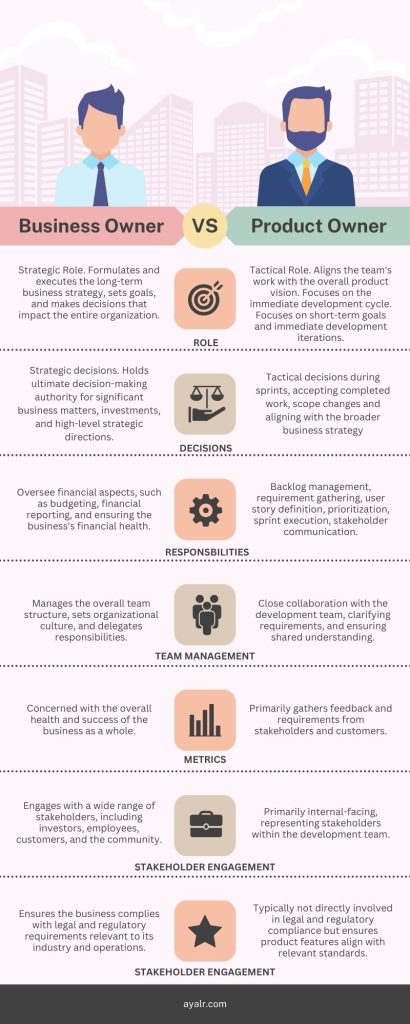Product Owner vs Business Owner: Distinguishing between the two is often challenging due to occasional role overlap. Both are pivotal stakeholders driving product and business advancement.
Confusion about the actual job of a Product Owner is very common, partly because the role is relatively new compared to that of a Business Owner, which has existed for decades. While the responsibilities of a Business Owner have been well-established over time, the emergence of the Product Owner role, particularly in the context of Agile methodologies, has introduced a new dynamic to business operations. This contrast in tenure and evolution often leads to misunderstandings about the misunderstandings about the Product Owner’s distinct duties and contributions of each role within an organization.
Is the Business Owner Higher than the Product Owner in the Organizational Hierarchy?

In terms of hierarchical structure, the Business Owner (BO) typically holds a higher position than the Product Owner (PO). The BO is usually at the top of the organizational hierarchy while the PO may not have direct reports or manage employees in a traditional sense. However, their role is critical in driving the success of the product and ensuring alignment with the overall business strategy. The PO collaborates closely with cross-functional teams, stakeholders, and sometimes reports to higher-level management, such as a Chief Product Officer or Director of Product Management.
The Role of a Product Owner
A Product Owner is essentially a Product Manager who acts as a Product Owner with the context of Agile and Scrum. So they are known for managing the backlog, planning sprints and collaborate closely with the development team ensuring efficient delivery of features.
Tip: POs operate at a more detailed level, overseeing the day-to-day development process.
A Product Owner’s role is crucial in Agile methodologies, where they play a hands-on part in defining user stories, setting priorities, and maintaining a well-groomed backlog. They work in close collaboration with the Scrum Master and the development team to ensure the product increments meet the defined criteria and that customer needs are met.
Product Owner Responsibilities
Product Vision: POs need to communicate and remind the product vision with the scrum team and other stakeholders, ensuring alignment with the overall business strategy.
Backlog Management: Maintainaning and prioritizing the product backlog is must for a PO so that Spring Planning can be done efficiently and effectively. The backlog is the future of the product with a list of features, enhancements, and fixes that are likely to be delivered in future sprints based on customer and business needs.
Collaboration: POs cannot work in a bubble and need to work closely with cross-functional teams, including developers, designers, and stakeholders, to deliver a successful product.
User Stories: Create and refine user stories, representing end-user requirements, and ensure they align with the product vision.
Sprint Planning: As part of the scrum team a PO is required to attend sprint planning sessions at the beginning of each sprint to determine the scope of work for a development’s iteration.
Acceptance of Deliverables: At the end of each sprint the product deliverables need to be reviewed and accepted as product increments. The PO ensures that the deliverables meet acceptance criteria and business requirements.
Feedback: Gathering and assessing feedback from stakeholders and end-users needs to be done at the end of each product development iterations. This is vital to continue to improve the product continuously.
In a nutshell, the Product Owner often acts as a bridge between customers, business owners, users and the development team. They are responsible for ensuring that the development team is working on the highest-priority items that align with the overall business goals and objectives.
The Role of a Business Owner
The Business Owner, legally known as the proprietor, is the person who has established and is operating a business. To swiftly establish a presence in the market, business owners draw upon their extensive knowledge of market dynamics and customer needs, launching new products. Additionally, they hire employees to manage various departments within their business. In non technical terns, It’s common for people to mistakenly call the “business owner” the product owner as he’s the owner of the idea and the one that gave the go ahead for the creation of the product. While a business owner is indeed the sponsor of all the business products and is business oriented , a PO focuses on the creative process of the product and is more product and user oriented. Here’s a breakdown of their primary responsibilities:
Business Owner Responsibility
Business Strategy: A business owner overseas the development and execution of the overall business strategy. This include long-term goals, market positioning, and growth plans.
Financial Management: He’s also responsibile of monitoring financial aspects, such as budgeting, financial reporting, and ensuring the business’s financial health.
Leadership and Decision-Making: A BO has to make critical decisions, and set the overall direction for the business.
Risk Management: This area is very important for the business success and stability. Though he would probably higher a professional to assess risk management, a Business Owner usually has the skills to identify on the best investments to make and those to avoid. Their experience in business gives them the leverage to Identify and manage risks before anyone else in the company.
Communicating with Stakeholders: Attracting investments and customers is also a key aspect of the Business Owner. Though he might not be directly involved in Sales and Finance – being able to attract potential customers and investors is something that many business owners do.
Legal Compliance: Business owners ensure compliance with legal and regulatory requirements relevant to the industry and business operations.
Team Management: The Business Owner is the one who is usually responsible with hiring the first staff and create a stepping stone in the company’s values.
What is the difference between a Product Owner and a Business Owner?
Now that we have look at the different responsibilities distinguishing a Business Owner from a Product Owner we can see that in an organizational setting these two roles have fewer overlaps than we might have thought of. While a Business Owner holds a comprehensive responsibility for the entire business, overseeing its overall strategy, financial health, legal compliance, and stakeholder engagement, the Product Owner’s focus is more specific, centered on the development, delivery, and success of a particular product or set of products.

Strategic vs. Tactical
Strategically, the Business Owner formulates and executes the long-term vision and goals for the business, making decisions that impact the organization as a whole. In contrast, the Product Owner operates more tactically, working to define and execute a distinct vision for a specific product, aligning it with the broader business strategy set by the Business Owner.
Stakeholder Engagement
In terms of stakeholder engagement, the Business Owner interacts with a diverse range of stakeholders, including investors, employees, customers, and the community. Meanwhile, the Product Owner usually collaborates more directly with development teams, designers, and stakeholders involved in the specific product’s creation. Nevertheless, a Product Owner might also need to communicate with investors, customers and the community in general. The different is that a BO is more concerned about the business rather than the single product.
Decision-Making Authority
Decision-making authority follows a similar pattern, with the Business Owner making decisions on significant business matters, investments, and high-level strategic directions. The Product Owner, however, focuses on decisions related to the product backlog, feature prioritization, and sprint planning, albeit within the scope of the specific product.
Business Health vs. Product Success
While the Business Owner is primarily concerned with the overall health and success of the business, the Product Owner is dedicated to ensuring the success of a particular product or set of products.
Team Management
In terms of team management, the Business Owner oversees the overall team structure, sets the organizational culture, and delegates responsibilities. Simultaneously, the Product Owner collaborates with cross-functional teams involved in the product development process. Basically the Business Owner is at the top of the hierarchy where often has the job managing the executives of the company. The Product Owner is effectively a Product Manager but does not manage any employee – his sole focus is the product though has to be effective in communicating with others
Legal and Regulatory Compliance
Finally, the Business Owner is responsible for ensuring legal and regulatory compliance for the business as a whole, while the Product Owner typically focuses on ensuring that product features align with relevant standards.
Conclusion
In conclusion, while the roles of a Business Owner and a Product Owner share the common goal of driving success within an organization, it’s vital not to overlap the roles for effective business management. The Business Owner should operate at a strategic level, overseeing the entirety of the business and making decisions that impact its overall health. On the other hand, the Product Owner should focus tactically on a specific product or set of products, ensuring their development aligns with the broader business strategy. Unfortunately, it’s very common to have Business Owner’s interfering with the Product Owner’s job with their key products but this usually hinders the operations of the company.
